Bringing earthworms back to this Hawke’s Bay beef farm was a labour of love

There’s an art to the science of regenerative farming and it has turned this conventionally-trained farmer into an earthworm warrior.
Words: Sheryn Dean Images: Craig Smith
Who: Craig Smith and Lana Kerr
Where: Waitara Valley, Te Pohue, 30 minutes north of Napier
Land: 282ha
What: 400 cattle, farm stay, bees, trees (carbon credits)
Web: outbacknz.com
When Craig Smith first started fencing on his idyllic beef farm along the banks of the Mohaka River, he discovered something was missing. “When we came here, you’d dig a post hole and not see a worm.”
Today, he and partner Lana Kerr are passionate about the health of their property and use regenerative farming techniques to grow their most important ‘crop’: good soil. “Now you see hundreds (of worms),” Craig says proudly.
The couple lives self-sufficiently on the farm, a mix of river flats and steep hills. “Lana has a large vegetable garden. When we want some meat, we hunt a deer or turkey. We have nurse cows raising calves that provide milk, and Lana makes cheese. We’re very much about healthy everything.”
But the way he farms now isn’t what he learned in his Diploma in Agriculture from Massey University or when he worked as a young farming cadet at Flock House, an agricultural training school.
“All the stuff we learned about was above the soil, apart from a soil test to check out what chemicals were missing. Nothing was discussed about microbes or how different plants produce different minerals.”
Now older (66) and wiser, Craig says farming is all about the soil. “Regenerate the soil, and as a result of that, everything else will follow.”
Regenerative farming (technically regenerative agriculture or RA) practices are being enthusiastically embraced by farmers worldwide. RA focuses on nurturing soil biology to build topsoil, sequestering carbon in the process, and retaining nutrients so they don’t leach into waterways.
“I am not overly interested in the technicalities,” says Craig. “But from a common sense perspective, if you feed the worms and microbes, then they’re going to provide the nutrients for the plants, and they’ll do well. The stock will do well because they eat the plants.”

Soil microbes are a mix of fungi, bacteria, algae, and single-celled animals. One teaspoon of soil contains:
■ around 1 billion bacteria;
■ several yards of fungal hyphae (threads or strands);
■ several thousand protozoa ;
■ a few dozen nematodes.
If you could tally up all the micro-organisms in that teaspoon, it’s more than the number of people on Earth. Scientists are yet to discover all the functions of soil microbes. Generally, they decompose organic matter, creating nutrient-rich soil. More simply, they make compost.
Worms are the giants of this underground ecosystem, and their presence is an indication of good soil health.
Craig and Lana didn’t use truckloads of fertiliser to improve their soil. Instead, they encouraged the growth of a diverse range of grasses – some that others would consider weeds – then let them die so soil organisms could compost them.
The only ‘inputs’ Craig has applied over the past nine years is a couple of doses of lime to raise the soil pH. He’s also sown chicory and plantain seed to increase the pasture diversity.
TALL GRASS GROWS LONG ROOTS
Pasture is allowed to grow tall to about gumboot height. It’s then intensively grazed for 2-4 days. Stock is moved onto the next paddock when the top third has been eaten.
The strategy has multiple beneficial effects for the grass plant and the soil biology.
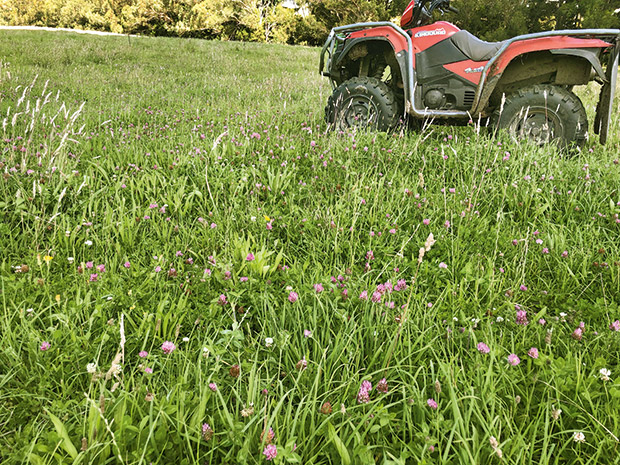
Too short to graze.
Long pasture leaves are always in proportion to their roots. Longer roots access nutrients and water at a much lower level in the soil, making it more resistant to drought. It can also access a lot more nutrients, resulting in better growth.
The roots of pasture plants store energy. Plants grazed continuously as they try to regrow soon use up all this energy. They’re unable to produce enough new leaves for the photosynthesis required to replace their energy stores. They get weaker over time and grow much more slowly or die.
Craig uses a short grazing period for his two mobs. Each of the 70 paddocks gets to rest and regrow for 70-140 days between grazings, depending on the time of year.
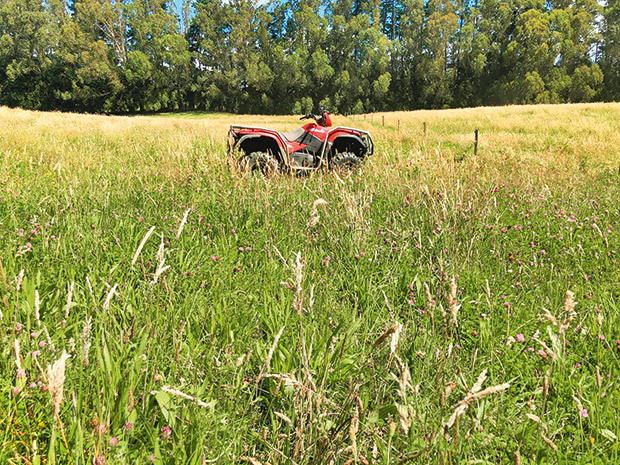
Ready to graze in a week.
It’s an intense grazing regime, with 200 cows in a 2ha field. It’s important they eat all the plants, not just their favourites, so less-palatable species don’t get a chance to dominate. Diversity of pasture species is encouraged as different plants:
■ supply a variety of minerals to stock;
■ have different root systems;
■ are preferred by stock at different times of year;
■ grow better in different seasons.
Anything not eaten, such as thistles, are damaged by trampling. Everything gets pooed on, creating an ideal food for the soil biology to turn it into humus.
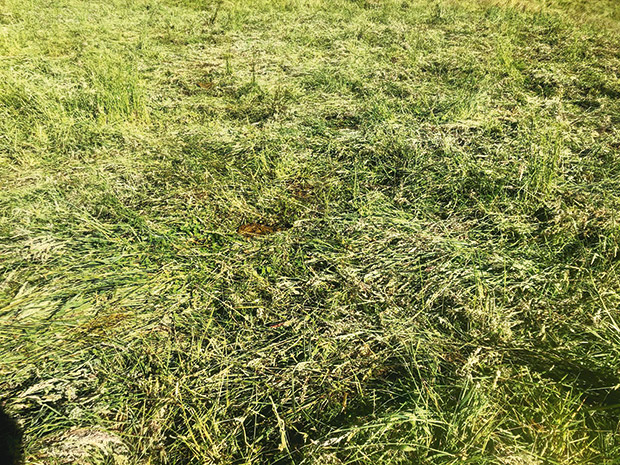
After grazing.
Grasses naturally feed the soil microbes between grazing. For example, ryegrass grows three leaves; as the fourth leaf sprouts, the first one dies and decomposes. Many farmers consider this a waste and always graze once there are three leaves. Craig considers every leaf that dies to
be natural fertiliser.
There are other benefits. A long grazing rotation breaks the life cycle of parasitic worms that can infect stock.
There’s also far less leaching. The healthier and more abundant the soil microbes, the more nutrients they hold. The teeming populations store it in a stable form, only converting it into a plant-available (and leachable) compound when plants require it.
Mycorrhizal fungi help with the conversion in exchange for sugar from the plant. They feed nutrients straight into the roots, so nothing is wasted or washed into waterways.
“We don’t want to put nitrates in our water,” says Craig. “People come to stay with us and they can swim and catch healthy fish from the river. We drink our river water.”
What is regenerative agriculture?
Regenerative agriculture (RA) is a system of farming principles and practices that increases biodiversity, enriches soils, improves watersheds, and enhances ecosystem services.
RA AIMS:
■ capture carbon in soil and aboveground biomass, reversing current global trends of atmospheric accumulation;
■ increase yields;
■ increase resilience to climate instability;
■ create healthier, more vital farming communities.
It’s based on decades of scientific and applied research into organic farming, agroecology, holistic management, and agroforestry.
RA PRACTICES:
■ no-till farming and crops;
■ organic annual cropping;
■ the use of compost, compost tea, biochar, terra preta (dark soil);
■ integration of trees, forage, and holistically managed grazing of domesticated animals;
■ ecological aquaculture;
■ perennial crops.
Growing the farm’s income
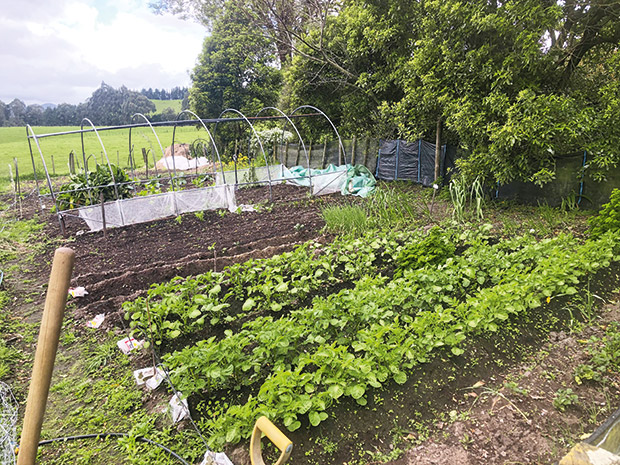
Craig and Lana share their natural environment with guests, generating another income stream. They’ve recently built a secluded cabin overlooking the river with an outdoor kitchen and rustic bathroom for those wanting to relax and enjoy the area’s tranquil beauty.
Lana hosts those wanting a more active rural experience in what was the shearer’s quarters. An accommodation block sleeps 20 people and has darts, a pool table, and a lounge in the converted woolshed.
Visitors can fish, hunt, milk the cow, walk, mountain bike, play paintball, shoot clay birds or out on the rifle range, swim, and raft on the river. You can even bring your horse and go trekking.
The couple have hosted stag parties in what they call a safe environment, although a recent groom-to-be was set afloat on a kayak to paddle through a barrage of paintballers. Other groups do team-building competitions where they make a raft (and often sink, says Craig).
“They keep me young,” he laughs.

He says they love sharing their way of life and unique space with other people. Craig and Lana also share it with young people who have been removed from their families, providing a safe space and the healing power of nature.
“We see a lot of farmer bashing, especially dairy farmers, because of nitrates in waterways. But I think the majority of us are farming because we love what we do. We love animals, and we care for our land. It’s good for people to come here and see and experience that for themselves.”
More recently, they’ve added beehives for honey, and forestry. Over 100 acres is now in pine trees and Craig plans to plant more this winter.
Their farm’s steep areas are prone to landslides and aren’t suitable for grazing. He says, at his age, he won’t see the benefits of the harvest, but carbon credits make it viable to plant now.
The focus is always on working in with nature.
“We think we’re clever, but nature is way more clever than we are.”
The top 3 things you can do for great soil biology
Three relatively inexpensive techniques do far more for soil biology than all the often-expensive biological fertilisers and microbial inoculants you can buy:
■ increase the amount and diversity of organic matter inputs;
■ reduce the amount and intensity of tillage;
■ diversify the number of crops/pasture species.
Source: Managing soil biota to deliver ecosystem services, www.naturalengland.org.uk
How RA enriches the soil
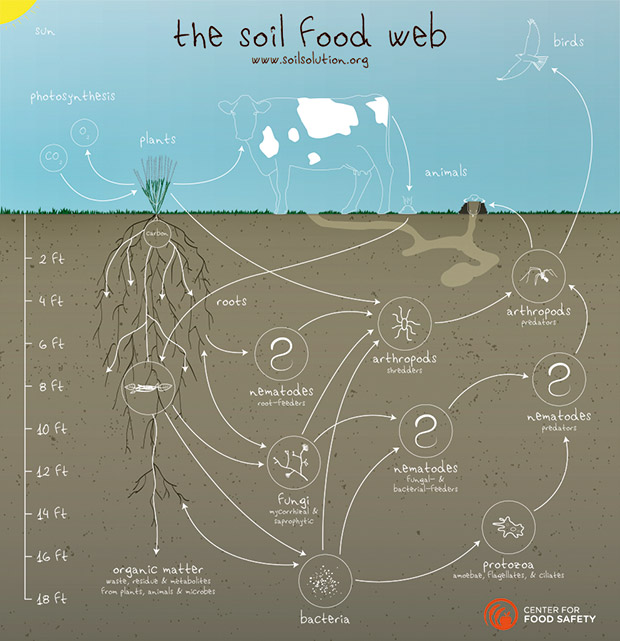
RA focuses on improving the health of the soil. By not tilling it, adding lots of organic matter, and other regenerative practices, large populations of soil organisms can flourish, naturally improving soil structure and fertility.
Shredder organisms such as earthworms, insects, and arthropods break up organic matter into small pieces. Fungi and bacteria decompose it, transforming it into nutrients that plants can use.
These are some of the critical soil organisms.
ARTHROPODS
Includes crustaceans such as woodlice/slaters, spiders, millipedes, and other insects which process organic matter.
NEMATODES
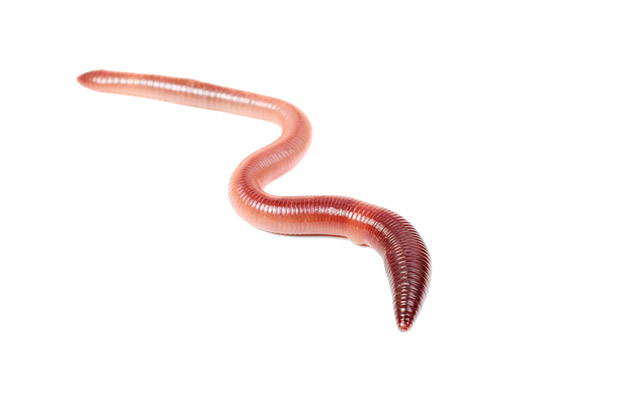
Microscopic worms that feed on plants, algae, bacteria, fungi, and other nematodes. Beneficial nematodes help to prevent disease by balancing levels of bacteria and fungi in soil. They also release nutrients through the soil in plant-available forms.
FUNGI
Delicate strands of fungal hyphae (known collectively as mycorrhizal fungi) are dormant until they sense plant roots getting close. This stimulates their growth, and they extend out into tiny soil pores and cracks where plant roots can’t reach.
In healthy soil, this can result in a 10-fold increase in a plant’s effective root surface area, which can double or triple its nutrient uptake.
Hyphae on the roots of one plant connect with other hyphae on nearby plants, helping them share nutrients, and boosting their growth.
They also significantly affect soil structure, increasing air and water infiltration, which improves plant growth. It helps prevent disease as well-aerated soil is less affected by pathogens, which prefer low oxygen environments.
BACTERIA
Microscopic single-celled organisms. Most decompose simple carbon compounds, such as root exudates and fresh plant litter, converting it into forms useful to other soil organisms.
They also retain nutrients such as nitrogen in their cells, preventing its loss from the rooting zone.
Bacteria in soil include:
■ mutualists that work with plants (eg to fix nitrogen);
■ lithotrophs that obtain energy from nitrogen, sulphur, iron, or hydrogen compounds, and help with nitrogen cycling and the degradation of pollutants.
PROTOZOA
Single-celled organisms that feed mostly on bacteria, and other protozoa, soluble organic matter, and sometimes fungi. As they eat, they release excess nitrogen which is used by plants and other organisms in the soil.
Sources: Soil Biology Primer (www.nrcs.usda.gov), Dr Elaine Ingham (www.soilfoodweb.com)
6 THINGS TO KNOW ABOUT SOIL ORGANISMS
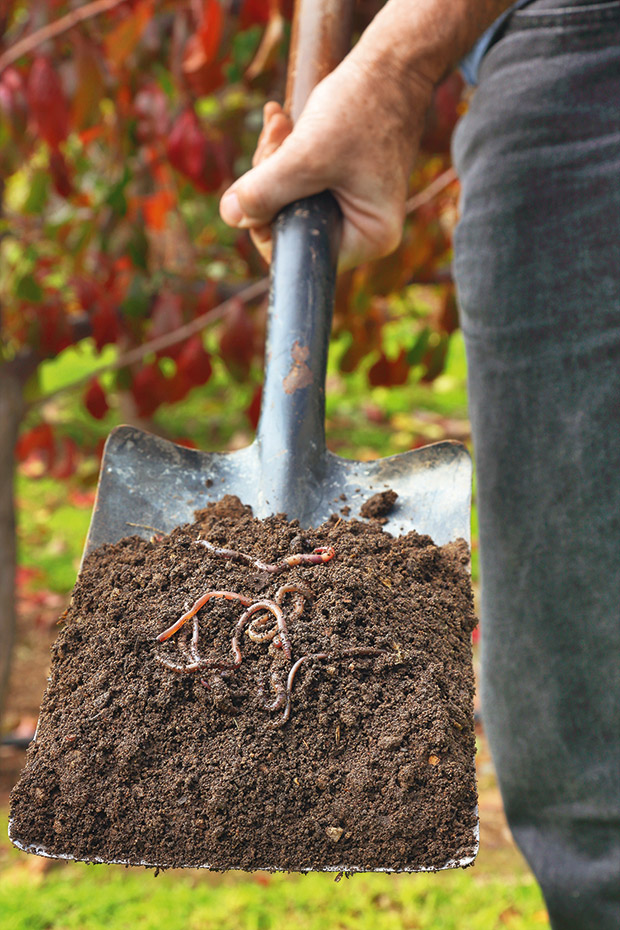
■ Most soil organisms live in the top 10cm of the soil, where organic matter is most concentrated, but some have been found as deep as 16km (during drilling for oil wells).
■ They’re not evenly distributed as they have different preferences for nutrients and moisture. However, most are found close to roots.
■ The rhizosphere is a thin layer of soil directly around a plant’s roots. It’s teeming with bacteria that feed on sloughed-off plant cells, proteins, and sugars released by roots.
■ Fungi are commonly found on plant litter as it contains large amounts of hard-to-decompose carbon. Fungal hyphae also distribute nitrogen to the underlying soil (something bacteria can’t do).
■ Soil is a combination of sand, silt, and clay. These primary particles can be bound together into what soil scientists call aggregates. Many aggregates are the faecal pellets of earthworms and other invertebrates.
■ Soil organisms work seasonally. In temperate systems, the greatest activity occurs in late spring when temperature and moisture conditions are optimal for growth. However, certain species are most active in the winter, during dry periods, or flooded conditions. At any time, only a fraction of the organisms in soil are ‘working’ – most are barely active or dormant.
Love this story? Subscribe now!
 This article first appeared in NZ Lifestyle Block Magazine.
This article first appeared in NZ Lifestyle Block Magazine.
